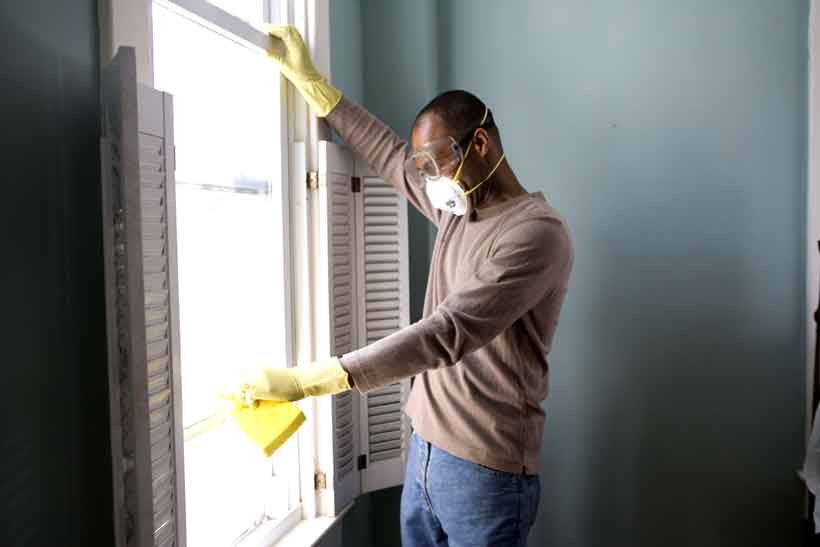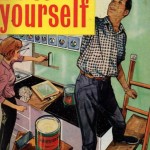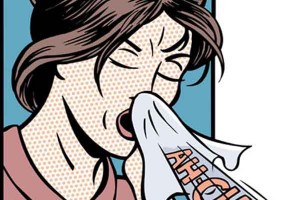I may get commissions for purchases made through links in this post.
Allergies can be a nightmare. Whether it’s you, your children, or your significant other suffering, nearly everyone has had some experience with asthma or allergies.
It can be difficult to determine the source of asthma or allergies – while we may think that we’ve gotten rid of a cause, allergens can be a little sneaky, hiding in furniture, in your pillow, at the bottom of a toy box.
While you may not always be able to identify the source of an allergy, it’s important to allergen-proof your home as much as possible to prevent any nasty allergens from getting in.
Here’s how to get rid of allergens at home effectively
After reading these 31 tips you’ll be an expert on how to allegergen proof the home and have learned;
- How to clean.
- What to get rid of in the home.
- Which preventative measures to take.
- Which allergy control products to choose.
The first – essential – step when getting rid of allergens at home..
The main causes of asthma are mold and dust, and if there is someone in your household suffering from asthma, it’s important to eliminate these as much as possible, even if it can be a little difficult to determine where they’re coming from.
Many people have allergies to animals, often dogs or cats and it goes without saying that it’s best to avoid a pet if you’re allergic to it, but even then, there are other steps that can be taken.
People can be allergic to pollen, grass and a whole range of things from outside, so it’s important to make sure that inside is safe.
Identifying what you or your family are allergic to is an important first step.
Seeing an allergy specialist is a good start, as they can identify your allergies and offer some tips for dealing with them. This WebMD allergy checklist is helpful too.
Too many people have gotten rid of their dog only to discover that they were allergic to grass
While you can’t strictly cure allergies, there are ways you can make life a little easier by allergy proofing your home.
Preventative measures
1: Keep windows closed
You can have the cleanest, most allergen free house in the world, but it’s still very easy for allergens to blow in from outside.
Keeping your windows closed will make a huge difference when it comes to keeping your home allergen free. That is, obviously, if your allergy is triggered by an outdoor source such as plant pollen.
2: Use an air conditioner rather than a fan
Ceiling and standing fans work by circulating the air along with dust and other allergens. An air conditioner provided it’s kept clean, blows cold air rather than circulating it and is much safer for those with asthma or allergies.
Keep in mind that allergens can be in air-conditioning and heating vents in the home. Home duct systems are known to contain leftovers from the construction process such as drywall dust, saw dust and concrete dust that may cause allergies.
An air conditioning allergen filter system offers a solution. It attracts and traps allergy-triggering particles like dust, mold spores and pollen but also smoke and smog from the air. It also increases efficiency and thus durability of air conditioning and heating systems.
3: Cover problem surfaces where possible
A lot of the time allergens can get trapped in furniture, toys and mattresses. Covering these with plastic covers will make a huge difference. They’re not end-all solutions though, they work best as part of an integral approach.
Use mattress covers and pillow protectors to keep you shielded from dust mite droppings that carry up over time. Dust mite poo is very dry, and breaks up easily releasing fine airborne particles that cause wheezing and other allergic reactions in so many people.
Dust is mostly dead skin flakes and is crawling with eight-legged bugs called dust mites. There are about 2 million of them in a typical mattress.
These encasements form a barrier between you and the allergens, thus reducing the need to buy new pillows and mattresses each few months or years.
4: Start a no-shoes policy in your home
Shoes are great at tracking in dirt and allergens from outside. Research has shown that approximately 35% a considerable amount of the contaminants inside your home are brought in from outdoors via your shoes.
If you get into the habit of making sure that you, your family and your guests leave shoes at the front door it will make it easier to keep all the allergens from outside from spreading through your house.
5: Don’t let clutter gather under the beds
A lot of people like to use the space underneath the bed to hide a lot of clutter, but this can be dangerous, as it attracts the build-up of dust.
Keeping the space underneath the bed clear, along with regular vacuuming, will make a world of difference when it comes to allergy proofing your bedroom.
6: Store only clean and dry clothes in the closet
While putting away clothes that still may be a little damp saves a lot of time and effort, it makes the closet the perfect breeding ground for mould and allergens. Make sure all clothes are clean and dry before putting them away.
7: Keep pets outside
It goes without saying that if you or a family member has an allergy to pet hair, to keep that pet outside. There is another risk with pets though, and that is that while they may not specifically be the cause of your allergy, they can bring in a lot of allergens in from outside. At the very least, give your furry family member a good bath before coming inside.
8: Keep an eye on kid’s toys
Stuffed animals can be a breeding ground for bacteria and allergens, and if your child is suffering from allergens, toys can often be the cause. Wash and thoroughly dry kid’s toys regularly, and try to rotate them – toys sitting at the bottom of the chest for months will gather dust.
9: Be careful with food waste
Be sure to immediately throw away any food scraps in a garbage can with an insect-proof lid. Scraps lying around can attract insects and vermin, bringing with them all the allergens they can carry.
10: Store food in air-locked containers
Once again, it’s important to avoid attracting insects and vermin. Storing food in air-locked containers in the fridge or pantry will help prevent pests from getting into your house and your food.
What to get rid of in the house in order to allergen-proof it
11: Replace carpet with different flooring where possible
Carpet traps a lot of dust and allergens, and while regular cleaning certainly helps, it can only do so much. If you’ve recently moved into a new place and you’re struggling to find the source of allergens, the carpet is a likely culprit. Hardwood flooring, tiles, or linoleum is much safer and easier to keep free of dust and allergens.
12: Avoid indoor plants
Yes it’s true that house plants purifiy indoor air but plants themselves can often be a cause of allergies, but on top of that, the soil in the pots is a breeding ground for bacteria, mould, and allergens.
Keep some pretty synthetic plants inside (be sure to dust and clean them regularly) and save real plants for outside.
13: Change air filters regularly
Keep to a strict schedule of changing the air filters on your heating and cooling system. To make this easier, mark your calendar on the dates where the air filters are due for a clean.
14: Avoid leaving wet clothes in the washing machine
Moisture, as we’ve said before, is not your friend. Leaving wet clothes in the washing machine for an extended period of time can lead to the growth of mold and bacteria, so dry your clothes as soon as possible.
15: Avoid upholstered furniture
When it comes to allergies, leather or vinyl furniture are the safest options. They trap lest dust and allergens, they’re easier to clean and can be quickly wiped down. If possible, replace your furniture with something more allergy-friendly.
16: Keep your home well ventilated
Keeping your home well ventilated can help you and your family breath a lot easier – fresh air flowing through the home can do wonders as long as you’re careful not to let dust or allergens in. If you have seasonal allergies, remember that this might not be a good idea at certain times of year.
17: Treat crawl-spaces
Lay plastic sheeting down in crawl spaces and be sure to keep them well ventilated. Be careful to make sure crawl spaces are sealed off from the rest of the home, because even if you’re careful, allergens will make crawl spaces their home.
Cleaning tips
18: Keep area rugs clean and dry
Area rugs are significantly better than carpet in homes because they can be washed or replaced, but that doesn’t mean that they’re completely safe.
Be sure to wash area rugs regularly and dry them thoroughly before putting them back down on the floor. Washing them won’t do much use if they’re left damp and welcoming mould growth.
Because this chore isn’t done too often, it may help to mark on the calendar when it’s time to wash the area rugs, every two months or so.
19: Keep the bathroom clean
Use a mould-killing cleaner in the bathroom, keep the walls and floor as dry as possible and make sure you clean it regularly.
Moisture is mould’s best friend, and as difficult as it can be to keep a bathroom dry, it’s important to do whatever you can to avoid mould and bacteria growing. A mold-killing cleaner will help kill off any problems, but prevention is always better.
20: Keep the house clean and dry
It goes without saying that cleaning the house regularly will go a long way towards preventing allergens, but it’s also extremely important to keep it dry.
Moisture leads to bacteria which can be very dangerous. Identify problem areas where moisture seeps in and do what you can to fix the problem. Fix any and all leaks in the home, and when a leak does occur, get on top of it straight away.
21: Use washable curtains
Allergens blowing in from outside can easily get trapped in the curtains, so if you can’t wash them, you can’t get rid of the allergens. If possible, replace dust-collecting blinds with washable curtains, and be sure to wash them regularly.
22: Wear a mask and gloves while cleaning

Cleaning your home is an important step in allergen proofing the home, but if cleaning sets off your allergies, then things can get a little tricky. Wearing a mask and gloves while vacuuming and cleaning can help protect you while you protect your household.
23: Toss out chemical cleaners
The chemicals in a lot of cleaners can be very harmful to you and your family’s health, especially if someone in the household suffers from allergies, asthma or respiratory problems.
Look for more natural cleaners where possible; water and a damp cloth will work in many situations where a chemical kitchen cleaner might normally be used and mint water is an effective insect repellent without all the harsh chemicals that are in fly-spray.
Remember it is easier and safer to clean up as you go, and that allows you to forgo any chemical cleaners later on.
24: Use a chore checklist
Anyone with a busy schedule knows how difficult it can be to keep track of all the housework, especially the jobs that aren’t staring us in the face – it’s easy to remember to wash the dishes when they’re piling up in the sink, but not as easy to see the dust on the floor that needs to be vacuumed or swept.
Using a checklist, whether it’s a physical sheet on the refrigerator or one of the many smartphone apps available, will help you keep on top of what needs to be done to keep your home safe, healthy, and allergen free.
25: Use a HEPA vacuum
The Mayo Clinic and WebMD advice to use a vacuum cleaner with a small-particle or a high-efficiency particulate air (HEPA) filter.
You can opt for an high-end vacuum that ‘s exceptional at cleaning carpet and is extremely quiet such as the Miele Complete C3 Brilliant Vacuum.
Or you can choose for a more affordable, yet still powerful, vacuum such as the Shark Navigator Lift-Away Professional Upright.
Allergy medicine and air-care
No method is fool-proof. It’s wise to always have allergy meds at hand.
26: Keep medications and inhalers at hand
Even if you’re careful, asthma and allergic reactions do happen. Keeping an inhaler in the bathroom, bedroom, kitchen and car is a good start to ensuring the safety of your family, as one is easily accessible at any point.
It’s important to remember that all medications and inhalers do have an expiration date, and some expire quicker than others.
It’s no use being able to quickly grab an inhaler from the kitchen cabinet if it’s one month out of date, so set a reminder or mark the calendar when it’s time to replace each of the inhalers.
It may help to give yourself a week’s notice so you have a little time to organize any prescriptions or even just time to go to the pharmacy and pick one up.
If your kids are going to a friend’s house, especially if they’re having a sleep over, make sure you send their inhaler or medication with them, because you never know what allergens they might run into.
27: Use a family air-care kit
The Family air-care kit was developed by the National Jewish Family Care association and is a device that attaches to your vacuum to catch and identify allergens that might be in your home.
The device is then mailed to National Jewish Health who analyse the sample and will send you a detailed report on the allergens in your home and the quality of the air. Identifying the allergens is always a good place to start.
Allergy control products
Gadgets and products that will help put an end to nasty allergy causes.
28. Vent filtration kit
Place vent filters over window screens and reduce your exposure to pollen in warm weather. This Allertech Vent Guard kit includes 20 vent filters that filter contaminants scattered by automobile and window air conditioner vents.
29: Utilize doormats
Keep one doormat outside your door and one inside, as this will help allergens from outside to stay outside. Replace doormats regularly, as even if you’re careful, allergens can and will get trapped in them.
The cost of a new doormat every month or so is a small price to pay for keeping your home and your family safe and healthy. It may help to mark on your calendar when it’s time to replace a doormat.
30: Use more allergy-friendly bedding
Avoid down comforters or pillows, as these are the cause of a lot of allergies and can attract dust. We spend a third of our lives asleep, so it’s important that we keep our bedrooms allergen-free. Find a material that works for you and your family, and stick with it.
31: Use dehumidifiers, turn off humidifiers
Humidity and moisture are the best friends of mould, so avoid using a humidifier, especially if you can see the windows getting foggy. Using a dehumidifier will draw moisture out, making it harder for mold to grow.
32: Use a vented exhaust fan over the stove
A vented exhaust fan removes cooking fumes and prevents moisture from coming into the kitchen. Moisture, as you know, is the enemy of anyone with allergies or asthma, so keeping it out of the kitchen will go a long way.
In addition, use a furnace filter.
33: Replace pillows as often as possible
We spend a third of our lives asleep, so an allergen-free bedroom is important. Many people with allergies have found that rather than strenuously trying to allergen-proof their bedroom, simply replacing their pillows every three months or so works wonders. It’s a relatively small expense for the sake of a good night’s sleep.
Dust mites’ most favorite place is your pillow. An average pillow harbors about 40,000 mites.
34: Use an allergen barrier comforter
Anti allergy bedding such as these allergen barrier comforters help protect against mold, mildew, and dust mites and, as such, keep sniffles away. If you’re prone to allergies, you will breathe easier and rest better.
35: Get a HEPA room air purifier
HEPA room air purifiers are made to reduce allergy symptoms, asthma, and even mild chemical sensitivities. They will significantly reduce your exposure to the indoor air pollutants responsible for triggering asthma and causing harmful health effects
A very well-reviewed, highly popular device is this 3 in 1 GermGuardian air cleaning system.























These are excellent tips for people who suffer with allergies. It also helps to ensure you clean your carpets, upholstery, mattresses, drapes etc every so often to keep them clean from dust, mites etc. which can be done by the home owner.
Paul
Excellent Tips